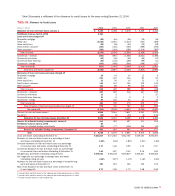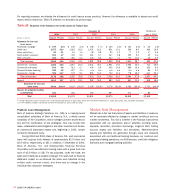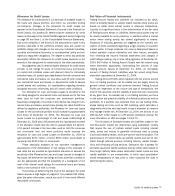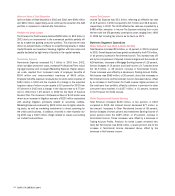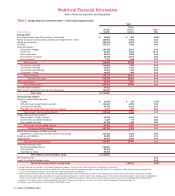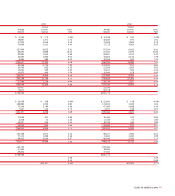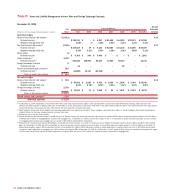Bank of America 2004 Annual Report Download - page 80
Download and view the complete annual report
Please find page 80 of the 2004 Bank of America annual report below. You can navigate through the pages in the report by either clicking on the pages listed below, or by using the keyword search tool below to find specific information within the annual report.
BANK OF AMERICA 2004 79
Allowance for Credit Losses
The allowance for credit losses is our estimate of probable losses in
the loans and leases portfolio and within our unfunded lending
commitments. Changes to the allowance for credit losses are
reported in the Consolidated Statement of Income in the Provision for
Credit Losses. Our process for determining the allowance for credit
losses is discussed in the Credit Risk Management section beginning
on page 58 and Note 1 of the Consolidated Financial Statements.
Due to the variability in the drivers of the assumptions made in this
process, estimates of the portfolio’s inherent risks and overall col-
lectibility change with changes in the economy, individual industries,
countries and individual borrowers’ or counterparties’ ability and will-
ingness to repay their obligations. The degree to which any particular
assumption affects the allowance for credit losses depends on the
severity of the change and its relationship to the other assumptions.
Key judgments used in determining the allowance for credit losses
include: (i) risk ratings for pools of commercial loans and leases,
(ii) market and collateral values and discount rates for individually
evaluated loans, (iii) product type classifications for both consumer and
commercial loans and leases, (iv) loss rates used for both consumer
and commercial loans and leases, (v) adjustments made to assess
current events and conditions, (vi) considerations regarding domestic
and global economic uncertainty, and (vii) overall credit conditions.
Our Allowance for Loan and Lease Losses is sensitive to the
risk rating assigned to commercial loans and leases and to the loss
rates used for both the consumer and commercial portfolios.
Assuming a downgrade of one level in the internal risk rating for com-
mercial loans and leases, except loans already risk rated Doubtful as
defined by regulatory authorities, the Allowance for Loan and Lease
Losses for the commercial portfolio would increase by approximately
$1.6 billion at December 31, 2004. The Allowance for Loan and
Lease Losses as a percentage of loan and lease outstandings at
December 31, 2004 was 1.65 percent and this hypothetical increase
in the allowance would raise the ratio to approximately 2.0 percent.
A 10 percent increase in the loss rates used on both the consumer
and commercial loan and lease portfolios would increase the
Allowance for Loan and Lease Losses at December 31, 2004 by
approximately $370 million, of which $250 million would relate to
consumer and $120 million to commercial.
These sensitivity analyses do not represent management’s
expectations of the deterioration in risk ratings or the increases in
loss rates but are provided as hypothetical scenarios to assess the
sensitivity of the Allowance for Loan and Lease Losses to changes in
key inputs. We believe the risk ratings and loss severities currently in
use are appropriate and that the probability of a downgrade of one
level of the internal credit ratings for commercial loans and leases
within a short period of time is remote.
The process of determining the level of the allowance for credit
losses requires a high degree of judgment. It is possible that others,
given the same information, may at any point in time reach different
reasonable conclusions.
Fair Value of Financial Instruments
Trading Account Assets and Liabilities are recorded at fair value,
which is primarily based on actively traded markets where prices are
based on either direct market quotes or observed transactions.
Liquidity is a significant factor in the determination of the fair value
of Trading Account Assets or Liabilities. Market price quotes may not
be readily available for some positions, or positions within a market
sector where trading activity has slowed significantly or ceased.
Situations of illiquidity generally are triggered by the market’s per-
ception of credit uncertainty regarding a single company or a specific
market sector. In these instances, fair value is determined based on
limited available market information and other factors, principally
from reviewing the issuer’s financial statements and changes in
credit ratings made by one or more rating agencies. At December 31,
2004, $4.4 billion of Trading Account Assets were fair valued using
these alternative approaches, representing five percent of total
Trading Account Assets at December 31, 2004. An immaterial
amount of Trading Account Liabilities were fair valued using these
alternative approaches at December 31, 2004.
Trading Account Profits, which represent the net amount earned
from our trading positions, can be volatile and are largely driven by
general market conditions and customer demand. Trading Account
Profits are dependent on the volume and type of transactions, the
level of risk assumed, and the volatility of price and rate movements
at any given time. To evaluate risk in our trading activities, we focus
on the actual and potential volatility of individual positions as well as
portfolios. At a portfolio and corporate level, we use trading limits,
stress testing and tools such as VAR modeling, which estimates a
range within which the next day's profit or loss is expected, to measure
and manage market risk. At December 31, 2004, the amount of our
VAR was $47 million based on a 99 percent confidence interval. For
more information on VAR, see pages 74 and 75.
The fair values of Derivative Assets and Liabilities traded in the
over-the-counter market are determined using quantitative models
that require the use of multiple market inputs including interest
rates, prices and indices to generate continuous yield or pricing
curves and volatility factors, which are used to value the position. The
predominance of market inputs are actively quoted and can be vali-
dated through external sources, including brokers, market transac-
tions and third-party pricing services. Estimation risk is greater for
derivative asset and liability positions that are either option-based or
have longer maturity dates where observable market inputs are less
readily available or are unobservable, in which case quantitative-
based extrapolations of rate, price or index scenarios are used in
determining fair values.




